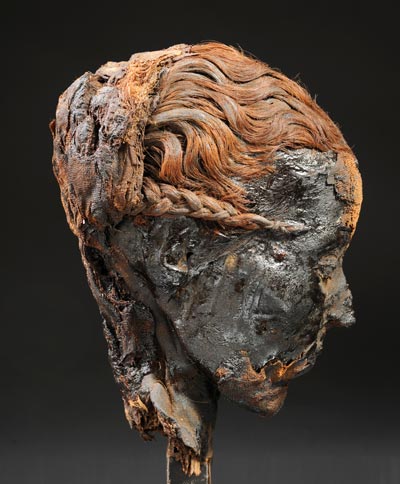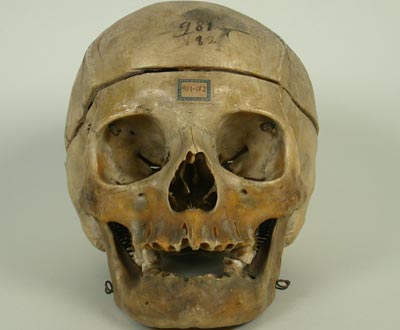Egyptian Collection
 Head of female Egyptian mummy of dynastic period (Middle Kingdom).
Head of female Egyptian mummy of dynastic period (Middle Kingdom).
The collection of Egyptian Anthropological specimens has a high scientific value: it is the fourth in the world for importance and consistence but the first for the research that has been conducted on it, above all in recent years.
It consists as a whole of more than 650 complete skeletons and 1,300 individual skulls, most of which are in an excellent state of conservation. Amongst the skeletons, 59 are of the neolitic period. Apart from the osteological material, the collection includes 80 heads of mummies (some predynastic), 5 almost complete predynastic mummies and 15 dynastic. The material was collected personally by Professor Morro who, in his capacity as anthropologist, took part in the archeological digs of the M.A.I. (Italian Archeological Expedition) in Egypt. Of all the foreign archeological digs on Egyptian soil, this was the only one to unite the purely archeological purpose with the anthropological one. The material comes mainly from the dynastic necropolis of Assiut and from the dynastic and predynastic one of Gebelen in Upper Egypt. It has been identified and classified cronologically (from VI to XI dynasty).
A collection of various skulls
 The anthropological collection of skulls and bones includes collections of various origins including a collection of Etruscan skulls (Tarquinia), a collection of skulls from Gargano, a collection of bones from an ancient ossary found in a cave in Susa (2nd century AD), a collection composed of 30 Longobard skulls from a necropolis at Testona (Moncalieri, Turin), various collections of skulls and bones from medieval Piedmont, and finally a collection of American Indian bones. In addition there is a collection of 99 skulls of insane persons (some pathalogical) put together between the end of the 19th century and the beginning of the 20th by Antonio and Giovanni Morro, both of whom were Directors of the Psychiatric Hospital in Collegno.
The anthropological collection of skulls and bones includes collections of various origins including a collection of Etruscan skulls (Tarquinia), a collection of skulls from Gargano, a collection of bones from an ancient ossary found in a cave in Susa (2nd century AD), a collection composed of 30 Longobard skulls from a necropolis at Testona (Moncalieri, Turin), various collections of skulls and bones from medieval Piedmont, and finally a collection of American Indian bones. In addition there is a collection of 99 skulls of insane persons (some pathalogical) put together between the end of the 19th century and the beginning of the 20th by Antonio and Giovanni Morro, both of whom were Directors of the Psychiatric Hospital in Collegno.
Cerebrological collection
Examples in formalin (including microcephalic and macrocephalic) and specimens fixed with the Muller process.
© MAE – All rights reserved
